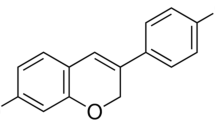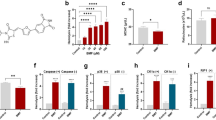Abstract
Chemotherapy-related anemia is a major obstacle in anticancer therapy. Tamoxifen (TAM) is an antiestrogen prescribed for breast cancer patients with hemolytic potential and apoptotic properties in nucleated cells. However, the eryptotic activity of TAM has hitherto escaped the efforts of investigators. RBCs from apparently healthy volunteers were treated with 1–50 μM of TAM for 24 h at 37 °C. Hemoglobin leakage and LDH, AST, and AChE activities were photometrically determined while K+, Na+, and Mg2+ were detected by ion-selective electrode. Flow cytometry was used to identify eryptotic cells by annexin-V-FITC, intracellular Ca2+ by Fluo4/AM, sell size and morphology by FSC and SSC signals, respectively, and oxidative stress by H2DCFDA. Whole blood was also exposed to 30 μM of TAM for 24 h at 37 °C to examine the toxicity of TAM to WBCs and platelets. TAM caused Ca2+-independent, dose-responsive hemolysis accompanied by K+, LDH, and AST leakage without improving the mechanical stability of RBCs in hypotonic environments. TAM treatment also increased the proportion of cells positive for annexin-V-FITC, Fluo4, and DCF, along with diminished FSC and SSC signals and AChE activity. Notably, TAM toxicity was aggravated by sucrose but abrogated by vitamin C, PEG 8000, and urea. Moreover, TAM exhibited distinct cytotoxic profiles against leukocytes and platelets. TAM-induced eryptosis is characterized by breakdown of membrane asymmetry, inhibition of AChE activity, Ca2+ accumulation, cell shrinkage, and oxidative stress. Vitamin C, PEG 8000, and urea may hold promise to subvert the undesirable toxic effects of TAM on RBCs.
Graphical abstract







Similar content being viewed by others
Data availability
The datasets generated during and/or analyzed during the current study are available from the corresponding author on reasonable request.
References
Suwalsky M, Hernandez P, Villena F, Aguilar F, Sotomayor CP. Interaction of the anticancer drug tamoxifen with the human erythrocyte membrane and molecular models. Z Naturforsch C J Biosci. 1998;53:182–90.
Cruz Silva MM, Madeira VM, Almeida LM, Custodio JB. Hemolysis of human erythrocytes induced by tamoxifen is related to disruption of membrane structure. Biochim Biophys Acta. 2000;1464:49–61.
Pretorius E, du Plooy JN, Bester J. A comprehensive review on eryptosis. Cell Physiol Biochem. 2016;39:1977–2000.
Alfhili MA, Alsughayyir J. Metabolic exhaustion and casein kinase 1alpha drive deguelin-induced premature red blood cell death. Xenobiotica. 2023;53:445–53.
Alfhili MA, Lee MH. Flow cytofluorometric analysis of molecular mechanisms of premature red blood cell death. Methods Mol Biol. 2021;2326:155–65.
Saebo IP, Bjoras M, Franzyk H, Helgesen E, Booth JA. Optimization of the hemolysis assay for the assessment of cytotoxicity. Int J Mol Sci. 2023;24:2914.
He J, Lin J, Li J, Zhang JH, Sun XM, Zeng CM. Dual effects of Ginkgo biloba leaf extract on human red blood cells. Basic Clin Pharmacol Toxicol. 2009;104:138–44.
Rawat A, Bhatt D, Kholiya S, Chauhan A, Bawankule DU, Chanotiya CS, et al. Comparative chemical composition and acetylcholinesterase (AChE) inhibitory potential of Cinnamomum camphora and Cinnamomum tamala. Chem Biodivers. 2023;20: e202300666.
Jemaa M, Fezai M, Bissinger R, Lang F. Methods employed in cytofluorometric assessment of eryptosis, the suicidal erythrocyte death. Cell Physiol Biochem. 2017;43:431–44.
Rouhimoghadam M, Safarian S, Carroll JS, Sheibani N, Bidkhori G. Tamoxifen-induced apoptosis of MCF-7 cells via GPR30/PI3K/MAPKs interactions: verification by ODE modeling and RNA sequencing. Front Physiol. 2018;9:907.
Lang E, Bissinger R, Qadri SM, Lang F. Suicidal death of erythrocytes in cancer and its chemotherapy: a potential target in the treatment of tumor-associated anemia. Int J Cancer. 2017;141:1522–8.
Mannucci PM, Bettega D, Chantarangkul V, Tripodi A, Sacchini V, Veronesi U. Effect of tamoxifen on measurements of hemostasis in healthy women. Arch Intern Med. 1996;156:1806–10.
Kato GJ, Steinberg MH, Gladwin MT. Intravascular hemolysis and the pathophysiology of sickle cell disease. J Clin Investig. 2017;127:750–60.
Alfhili MA, Alsalmi E, Aljedai A, Alsughayyir J, Abudawood M, Basudan AM. Calcium-oxidative stress signaling axis and casein kinase 1alpha mediate eryptosis and hemolysis elicited by novel p53 agonist inauhzin. J Chemother. 2022;34:247–57.
Ortiz J, Teruel JA, Aranda FJ, Ortiz A. On the mechanism of membrane permeabilization by tamoxifen and 4-hydroxytamoxifen. Membranes (Basel). 2023;13:292.
Lang PA, Huober J, Bachmann C, Kempe DS, Sobiesiak M, Akel A, et al. Stimulation of erythrocyte phosphatidylserine exposure by paclitaxel. Cell Physiol Biochem. 2006;18:151–64.
Mahmud H, Foller M, Lang F. Suicidal erythrocyte death triggered by cisplatin. Toxicology. 2008;249:40–4.
Brun JF, Varlet-Marie E, Myzia J, Raynaud de Mauverger E, Pretorius E. Metabolic influences modulating erythrocyte deformability and eryptosis. Metabolites. 2021;12:4.
Lagadec C, Adriaenssens E, Toillon RA, Chopin V, Romon R, Van Coppenolle F, et al. Tamoxifen and TRAIL synergistically induce apoptosis in breast cancer cells. Oncogene. 2008;27:1472–7.
Liu CY, Hung MH, Wang DS, Chu PY, Su JC, Teng TH, et al. Tamoxifen induces apoptosis through cancerous inhibitor of protein phosphatase 2A-dependent phospho-Akt inactivation in estrogen receptor-negative human breast cancer cells. Breast Cancer Res. 2014;16:431.
Li W, Shi X, Xu Y, Wan J, Wei S, Zhu R. Tamoxifen promotes apoptosis and inhibits invasion in estrogen-positive breast cancer MCF-7 cells. Mol Med Rep. 2017;16:478–84.
Gupta S, Belle VS, Kumbarakeri Rajashekhar R, Jogi S, Prabhu RK. Correlation of red blood cell acetylcholinesterase enzyme activity with various RBC indices. Indian J Clin Biochem. 2018;33:445–9.
Saldanha C. Human erythrocyte acetylcholinesterase in health and disease. Molecules. 2017;22:1499.
Pan X, Giustarini D, Lang F, Rossi R, Wieder T, Koberle M, et al. Desipramine induces eryptosis in human erythrocytes, an effect blunted by nitric oxide donor sodium nitroprusside and N-acetyl-l-cysteine but enhanced by calcium depletion. Cell Cycle. 2023. https://doi.org/10.1080/15384101.2023.2234177.
Oscarson DW, Van Scoyoc GE, Ahlrichs JL. Effect of poly-2-vinylpyridine-N-oxide and sucrose on silicate-induced hemolysis of erythrocytes. J Pharm Sci. 1981;70:657–9.
Kameneva MV, Repko BM, Krasik EF, Perricelli BC, Borovetz HS. Polyethylene glycol additives reduce hemolysis in red blood cell suspensions exposed to mechanical stress. ASAIO J. 2003;49:537–42.
Lang KS, Myssina S, Lang PA, Tanneur V, Kempe DS, Mack AF, et al. Inhibition of erythrocyte phosphatidylserine exposure by urea and Cl. Am J Physiol Renal Physiol. 2004;286:F1046–53.
Umemoto A, Monden Y, Lin CX, Abdul-Momen M, Ueyama Y, Komaki K, et al. Determination of tamoxifen–DNA adducts in leukocytes from breast cancer patients treated with tamoxifen. Chem Res Toxicol. 2004;17:1577–83.
Gowdini E, Aleyasin SA, Ramezani N, Nafisi N, Tutuni M. DOK7 CpG hypermethylation in blood leukocytes as an epigenetic biomarker for acquired tamoxifen resistant in breast cancer. J Hum Genet. 2023;68:33–8.
Johnson KE, Forward JA, Tippy MD, Ceglowski JR, El-Husayni S, Kulenthirarajan R, et al. Tamoxifen directly inhibits platelet angiogenic potential and platelet-mediated metastasis. Arterioscler Thromb Vasc Biol. 2017;37:664–74.
National Center for Biotechnology Information. “PubChem Compound Summary for CID 2733526, Tamoxifen” PubChem. https://pubchem.ncbi.nlm.nih.gov/compound/Tamoxifen. Accessed 29 Aug 2023.
Acknowledgements
The authors extend their appreciation to the Deputyship for Research and Innovation, Ministry of Education, Saudi Arabia for funding this work through grant number IFKSURC-1-4407.
Funding
This work was financially supported by the Deputyship for Research and Innovation, Ministry of Education, Saudi Arabia through grant number IFKSURC-1-4407.
Author information
Authors and Affiliations
Contributions
Conceptualization, MAA; methodology, all authors; software, JA; validation, all authors; formal analysis, AMA; investigation, all authors; resources, MAA and JA; data curation, all authors; writing—original draft preparation, all authors; writing—review and editing, all authors; visualization, all authors; supervision, MAA; project administration, MAA; funding acquisition, MAA. All authors have read and agreed to the published version of the manuscript.
Corresponding author
Ethics declarations
Conflict of interest
The authors have no relevant financial or non-financial interests to disclose.
Ethical approval
This study was performed in line with the principles of the Declaration of Helsinki. Approval was granted by the Ethics Committee of King Saud University Medical City (approval date: July 17, 2023/No. E-23-7706).
Consent to participate
Informed consent was obtained from all individual participants included in the study.
Consent to publish
Not applicable.
Additional information
Publisher's Note
Springer Nature remains neutral with regard to jurisdictional claims in published maps and institutional affiliations.
Rights and permissions
Springer Nature or its licensor (e.g. a society or other partner) holds exclusive rights to this article under a publishing agreement with the author(s) or other rightsholder(s); author self-archiving of the accepted manuscript version of this article is solely governed by the terms of such publishing agreement and applicable law.
About this article
Cite this article
Alfhili, M.A., Alyousef, A.M. & Alsughayyir, J. Tamoxifen induces eryptosis through calcium accumulation and oxidative stress. Med Oncol 40, 333 (2023). https://doi.org/10.1007/s12032-023-02205-4
Received:
Accepted:
Published:
DOI: https://doi.org/10.1007/s12032-023-02205-4




